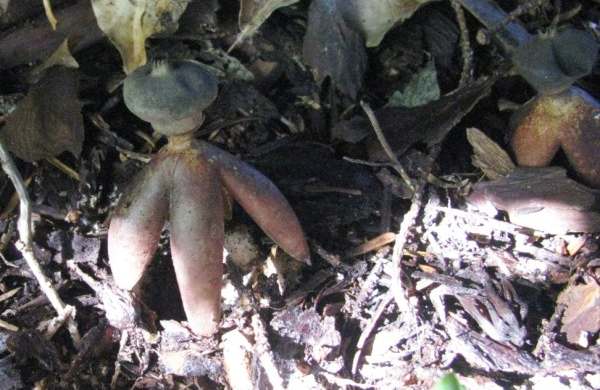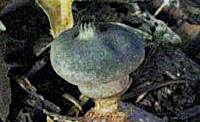Trees Birds Mammals Fish Amphibians Reptiles
Wild Algarve
Bookshop
Geastrum fornicatum (Huds.) Hook. - Arched Earthstar
Phylum: Basidiomycota - Class: Agaricomycetes - Order: Geastrales - Family: Geastraceae
Distribution - Taxonomic History - Etymology - Identification - Culinary Notes - Reference Sources

Instead of lying flat or folding beneath the spore sac, the rays of this rather uncommon earthstar stand on their tips, usually still attached to the remains of a basal cup. Found particularly under old Yew trees, the Arched Earthstar also occurs occasionally under other conifers and less frequently beneath broadleaf deciduous trees.
The specimen pictured here was photographed by Mike and Hilary Rose; it was beneath a Yew tree in a churchyard near Monmouth, Wales.
Unlike most other earthstar species, the rays of Geastrum fornicatum stand up on their tips rather than lying flat on the ground. This process raises up the spore-bearing inner peridium (the spore sac) and so increases the chances of spores being swept away on the breeze to alight far from their parent fruitbody. Unlike the Barometer Earthstar Astraeus hygrometricus, the rays of the Arched Earthstar are not hygroscopic, and so once the rays have become fully extended they remain in much the same position come rain or shine.
Distribution
From mid summer through to winter and often into the following spring the Arched Earthstar can be seen in a few places in Britain and Ireland, mainly in the south, but this is a rare earthstar and its conservation status was assessed as Vulnerable in the Red Data List prepared by Bruce Ing in 1992; it does not appear on the 2006 List, however.
Taxonomic history
Descriptions of the Dwarf Earthstar date back at least as far as the late 17th century. When James Sowerby reported this fact in his treatise Colored Figures of English Fungi or Mushrooms (published in 1799) he noted that this '...strange vegetable has surprised many; and in the year 1695 it was published under the name of Fungus Anthropomorphus, and figured with human faces on the head.' Well, I have looked very carefully but so far I have not seen any of the faces, but these earthstars do have silhouettes reminiscent of ballet dancers. (One of the common names given to this species in the USA is the Acrobatic earthstar.)
The basionym of this species dates from 1762 when the Arched Earthstar was described scientifically by British naturalist William Hudson (1730 - 1793), who gave it the binomial scientific name Lycoperdon fornicatum (effectively identifying it as a kind of puffball). In 1821 another British botanist-mycologist, Sir William Jackson Hooker (1785 - 1865), transferred this species to the genus Geastrum and so its scientific name became Geastrum fornicatum. Hooker, incidentally, was the first Director of the Royal Botanic Gardens, Kew, an institution whose contribution to mycological knowledge has been and continues to be immense.
Synonyms of Geastrum fornicatum include Lycoperdon fornicatum Huds.
Etymology
Geastrum, the generic name, comes from Geo- meaning earth, and -astrum meaning a star. Earthstar it is, then. The specific epithet fornicatum means arched.
Identification guide
 |
Fruitbody
5 to 8cm tall, with rays typically 4 to 7.5cm long and spore sac (bulb) 1.5 to 2.5cm across, with 4 or 5 rays, brown often tinged with blue or purple; standing upright on ray tips that usually remain attached to a basal cup; the short-stalked; round or subglobose spore sac is grey-buff with a rough surface and a fibrous apical pore. |
| |
Spores
Globose, warty, 3.5-4μm diameter excluding the warts.
Spore mass
Dark brown. |
Odour/taste |
Not noticeable. |
Habitat |
Mainly found under yew trees and occasionally other conifers; much less frequently with hardwood trees. |
Season |
Fruiting in the autumn; long lasting, and often visible all year round. |
Similar species |
Several other Geastrum species are of the same general form, and confident identification requires a lot of expertise. |
Culinary Notes
Earthstars are inedible and have no culinary value, but when dried they can make attractive table decorations as long as they do not get mistaken for pepper shakers!
Reference Sources
Fascinated by Fungi, 2nd Edition, Pat O'Reilly 2016, reprinted by Coch-y-bonddu Books in 2022.
Pegler, D.N., Laessoe, T. & Spooner, B.M (1995). British Puffballs, Earthstars and Stinkhorns. Royal Botanic Gardens, Kew.
Ellis J B, Ellis M B. (1990). Fungi without Gills (Hymenomycetes and Gasteromycetes): an Identification Handbook. London: Chapman and Hall. ISBN 0-412-36970-2.
Allen, Mea (1967). The Hookers of Kew 1785-1911. Joseph, London.
Dictionary of the Fungi; Paul M. Kirk, Paul F. Cannon, David W. Minter and J. A. Stalpers; CABI, 2008
Taxonomic history and synonym information on these pages is drawn from many sources but in particular from the British Mycological Society's GB Checklist of Fungi.
Top of page...
Fascinated by Fungi. Back by popular demand, Pat O'Reilly's best-selling 450-page hardback book is available now. The latest second edition was republished with a sparkling new cover design in September 2022 by Coch-y-Bonddu Books. Full details and copies are available from the publisher's online bookshop...